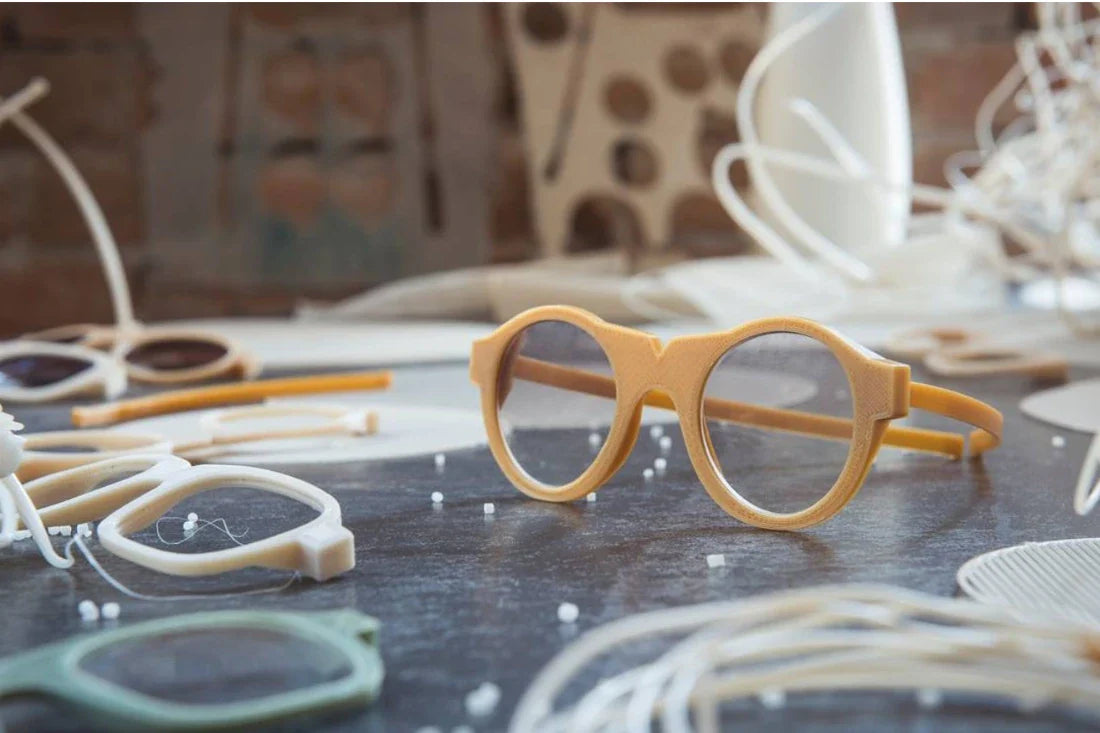Eyewear is more than just a practical accessory; it’s a statement of style, sophistication, and individuality. But behind every pair of trendy sunglasses or classic optical glasses lies a crucial element that often goes unnoticed—the material of the frames.
This guide delves deep into the world of plastic materials used in eyewear frames, exploring their characteristics, uses, and evolution over time. Whether you’re a fashion aficionado or simply curious about what goes into your favorite eyewear, this comprehensive overview will shed light on the intricate world of plastic frame materials .
1. Acetate: The Timeless Classic
Acetate , also known as cellulose acetate, is one of the most popular materials for eyewear frames, and for good reason. Originating from the early 20th century, acetate frames have become synonymous with high-quality eyewear due to their durability, versatility, and aesthetic appeal.
Characteristics:
Lightweight: Acetate is lighter than many other plastics, making it comfortable for extended wear.
Flexibility: It can be easily molded into various shapes and sizes, offering a wide range of design possibilities.
Vibrant Colors and Patterns: Acetate can be infused with various colors and patterns, allowing designers to create eye-catching frames.
Uses: Acetate is often used for both prescription glasses and sunglasses. Its ability to be shaped into intricate designs makes it a favorite for designer eyewear. Furthermore, its hypoallergenic properties ensure it is suitable for sensitive skin.
Evolution: Introduced in the 1920s as a more flexible and comfortable alternative to metal frames, acetate has undergone numerous innovations. Modern acetate is produced using an eco-friendly process, aligning with sustainability trends in fashion.
Cost: Acetate is generally more expensive than basic plastic alternatives due to its high-quality finish and durability. The price can vary depending on the brand, design complexity, and the specific type of acetate used. Expect to pay a premium for designer frames made from acetate.
2. TR90: The Modern Marvel
TR90 is a relatively new plastic material in the eyewear industry, but its innovative properties have quickly made it a go-to choice for contemporary eyewear.
Characteristics:
Super Lightweight: TR90 is incredibly light, which adds to the comfort of wearing glasses.
High Impact Resistance: It boasts excellent durability and can withstand considerable stress without breaking.
Flexibility: TR90 is known for its flexibility, allowing frames to bend without losing their shape.
Uses: TR90 is commonly used in sports eyewear and casual frames due to its durability and flexibility. It’s also a popular choice for affordable yet high-quality eyewear.
Evolution: Developed in the early 1990s, TR90 has quickly gained popularity due to its superior performance and affordability. Its rise aligns with the increasing demand for lightweight, durable eyewear options.
Cost: TR90 is typically less expensive than acetate and some other high-end plastics. Its affordability makes it a popular choice for budget-conscious consumers, while still offering impressive durability and comfort.
3. Nylon: The Flexible Contender
Nylon is another versatile plastic used in eyewear frames. Its unique properties make it suitable for a range of applications.
Characteristics:
Flexibility and Strength: Nylon frames are both strong and flexible, providing comfort and durability.
Resilience to Temperature Changes: Nylon can handle extreme temperatures without warping.
Color Retention: It holds color well, which helps in maintaining the aesthetic quality of the frames over time.
Uses: Nylon is often used in sports eyewear and high-performance glasses due to its flexibility and resilience. It is also used in prescription glasses for its comfort and durability.
Evolution: Nylon frames have been around since the mid-20th century. Advances in nylon technology have improved its flexibility and strength, making it a popular choice for high-performance eyewear.
Cost: Nylon frames are usually priced in the mid to lower range compared to acetate and polyamide. They offer good value for money, balancing durability and cost-effectiveness.
4. Polyamide: The Advanced Choice
Polyamide, often referred to as nylon, is a synthetic polymer known for its superior properties in eyewear.
Characteristics:
Durability: Polyamide is incredibly durable and resistant to abrasion.
Lightweight and Flexible: It combines lightness with flexibility, ensuring comfort and strength.
Resistant to Chemicals: Polyamide is resistant to chemicals, which helps in maintaining the frame’s appearance.
Uses: Polyamide is used in a variety of eyewear applications, including high-end designer frames and functional sports eyewear. Its resilience and comfort make it a versatile choice for many uses.
Evolution: Polyamide has seen significant advancements in its production and processing, leading to improved performance and expanded applications in eyewear.
Cost: Polyamide frames are typically in the mid to higher range. Their durability and advanced properties contribute to a higher price point compared to basic plastics but can be more affordable than premium acetate options.
5. Recycled Plastics: The Sustainable Solution
As sustainability becomes increasingly important in fashion, recycled plastics are emerging as a responsible choice for eyewear frames. Recycled materials are transforming the eyewear industry by offering eco-friendly alternatives to traditional plastics.
Characteristics:
Environmental Impact: Recycled plastics reduce waste and lower the demand for new raw materials, helping to minimize environmental impact.
Quality and Durability: Recycled plastics can be just as durable and high-quality as their non-recycled counterparts. Many recycled plastics undergo rigorous processing to ensure they meet industry standards.
Variety: Recycled plastics can come in various forms, including recycled acetate, which retains many of the desirable properties of traditional acetate.
Uses: Recycled plastics are used in a growing number of eyewear collections, especially among brands that prioritize sustainability. They are found in both high-end and affordable eyewear, reflecting a commitment to reducing environmental impact.
Evolution: The use of recycled plastics in eyewear has gained momentum in the last decade as part of a broader movement towards sustainable fashion. Innovations in recycling technology and increased consumer demand for eco-friendly products have accelerated this trend.
Cost: Recycled plastics can vary in cost. While some recycled options are priced similarly to their non-recycled counterparts, others may be slightly more expensive due to the additional processing required. However, many consumers are willing to pay a premium for the environmental benefits associated with recycled materials.
Conclusion: Choosing the Right Plastic for Your Eyewear
Understanding the different types of eyewear plastic can help you make an informed choice when selecting your next pair of glasses. Whether you prioritize style, durability, or comfort, there’s a plastic material that fits your needs.
Acetate remains a classic choice due to its versatility and vibrant designs, while modern materials like TR90 offer advanced performance for active lifestyles. Nylon and polyamide bring additional flexibility and durability, catering to various functional needs. Recycled plastics present a sustainable option for those who want to reduce their environmental footprint.
Cost is an important consideration as well, with acetate being one of the more expensive options, while TR90 offer affordable yet high-quality alternatives. Nylon and polyamide strike a balance, offering good value for money, and recycled plastics provide an eco-friendly choice with varying costs.
By being aware of these materials and their properties, you can choose eyewear that not only enhances your style but also meets your practical needs. At LookerOnline, we offer a range of premium designer eyewear frames crafted from the highest quality plastics, ensuring you get the best of both worlds—fashion and functionality. Explore our collection to find the perfect pair of frames that suits your style and needs.





